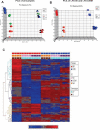A molecular signature of normal breast epithelial and stromal cells from Li-Fraumeni syndrome mutation carriers
- PMID: 21311097
- PMCID: PMC3039408
- DOI: 10.18632/oncotarget.175
A molecular signature of normal breast epithelial and stromal cells from Li-Fraumeni syndrome mutation carriers
Abstract
Specific changes in gene expression during cancer initiation should enable discovery of biomarkers for risk assessment, early detection and targets for chemoprevention. It has been previously demonstrated that altered mRNA and proteome signatures of morphologically normal cells bearing a single inherited "hit" in a tumor suppressor gene parallel many changes observed in the corresponding sporadic cancer. Here, we report on the global gene expression profile of morphologically normal, cultured primary breast epithelial and stromal cells from Li-Fraumeni syndrome (LFS) TP53 mutation carriers. Our analyses identified multiple changes in gene expression in both morphologically normal breast epithelial and stromal cells associated with TP53 haploinsufficiency, as well as interlocking pathways. Notably, a dysregulated p53 signaling pathway was readily detectable. Pharmacological intervention with the p53 rescue compounds CP-31398 and PRIMA-1 provided further evidence in support of the central role of p53 in affecting these changes in LFS cells and treatment for this cancer. Because loss of signaling mediated by TP53 is associated with the development and survival of many human tumors, identification of gene expression profiles in morphologically normal cells that carry "one-hit" p53 mutations may reveal novel biomarkers, enabling the discovery of potential targets for chemoprevention of sporadic tumors as well.
Figures






Comment in
-
A new therapeutic basis for treating Li-Fraumeni Syndrome breast tumors expressing mutated TP53.Oncotarget. 2010 Nov;1(7):470-471. doi: 10.18632/oncotarget.183. Oncotarget. 2010. PMID: 21317445 Free PMC article. No abstract available.
References
-
- Li FP, Fraumeni JF., Jr Soft-tissue sarcomas, breast cancer and other neoplasms. A familial syndrome? Ann of Int Med. 1969;71:747–52. - PubMed
-
- Li FP, Fraumeni JF, Jr, Mulvihill JJ, et al. A cancer family syndrome in twenty-four kindreds. Cancer Res. 1988;48:5358–62. - PubMed
-
- Srivastava S, Zou Z, Pirollo K, Blattner W, Chang E. Germ-line transmission of a mutated p53 gene in a cancer-prone family with Li-Fraumeni syndrome. Nature. 1990;348:747–9. - PubMed
Publication types
MeSH terms
Substances
Grants and funding
LinkOut - more resources
Full Text Sources
Medical
Molecular Biology Databases
Research Materials
Miscellaneous

